The United Nations has declared 2023 as the year of the millet. Once called “cereals of the poor”, in 2018 the Indian government gave this superfood a face-lift and renamed it ‘nutricereals’. Ever since, millets have become a popular alternative to rice and wheat.
Experts believe that millets are one of the oldest foods known to humans, also the first among cereals to be domestically cultivated. A rich source of nutrients like carbohydrates, protein, dietary fiber, good-quality fat, the grain contains high quantities of minerals and is gluten-free.
Millets benefit the consumer, cultivator, and climate. These rain-fed crops require minimum water, are climate-resilient and can be grown among other crops as well. Their growing season is much shorter than that of rice and wheat.
Celebrate this uzhavar thirunaal (farmer’s festival) with these millet-based recipes.
Bhogi
Foxtail millet (Thinai) sweet potato Poli
Serving size: 5-6 Polis
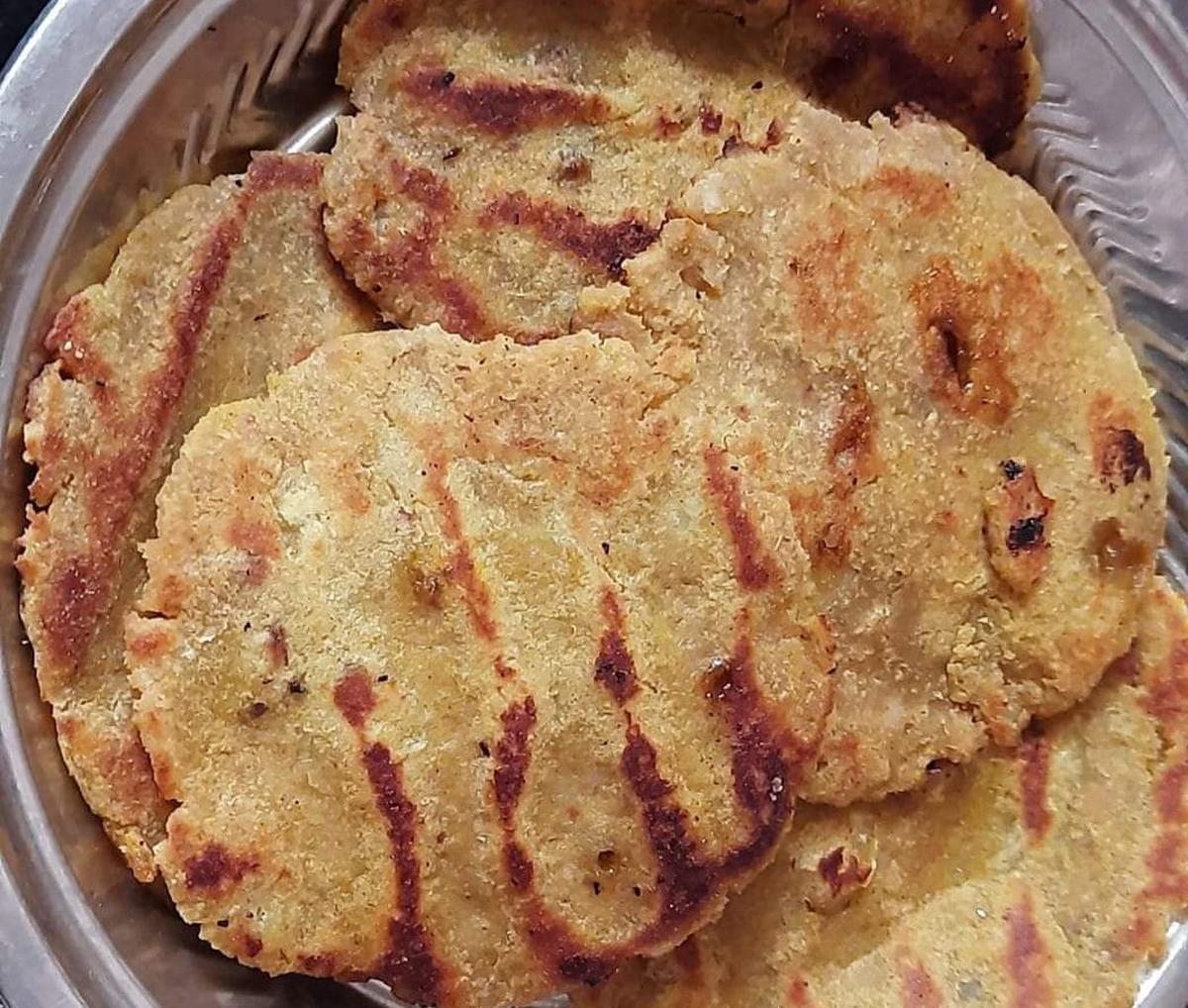
Sweet Potato millet poli
| Photo Credit:
Special Arrangement
Ingredients
Thinai millet flour – 1 cup
Sweet potatoes – 2 small tubers
Country sugar- 1/2 cup
Cardamom – 2 pods
Coconut oil to cook the Poli
Preparation
- Steam the sweet potatoes and mash them with a fork or masher (Note: If you boil the sweet potatoes, make sure they don’t retain any water)
- Mix the sweet potatoes with the millet flour, country sugar and knead it into a dough, using as little water as possible.
- Split the dough into 6 balls
- Roll into thick rotis with a rolling pin
- Place the poli on a tawa or non-stick pan with one teaspoon of coconut oil
- Allow the poli to cook on both sides and serve hot
Little millet (Saamai) pepper pongal
Serving size: 2-3
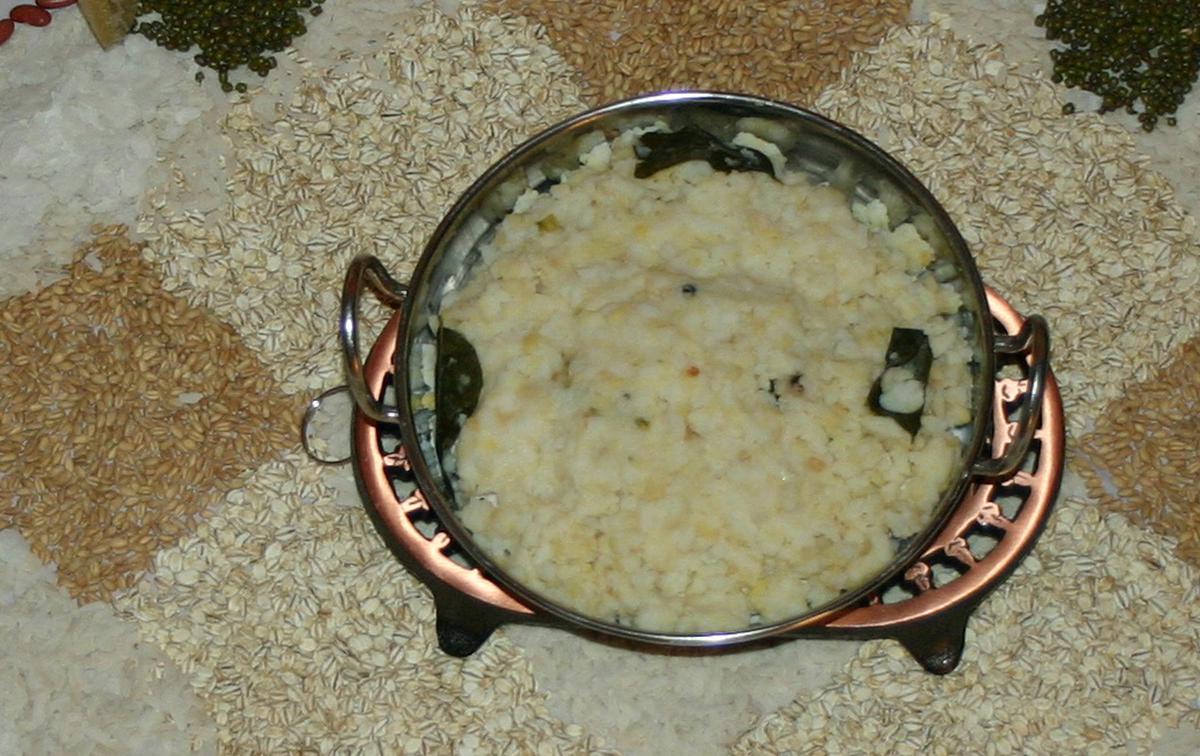
Pepper Pongal
Ingredients
Little millet (Saamai) – 1 1/2 cups
Whole or broken green gram – 1/2 cup
Whole black pepper – 1 tsp
Cumin (Jeera) – 1 tsp
Ghee / coconut oil – 5 tsp
1 inch ginger – finely chopped
Handful of curry leaves
Preparation
- Dry roast both the little millet and green gram separately, until they turn light brown
- Soak the roasted little millet and green gram in water for four hours
- Once soaked, discard the water and add four cups water and cook the little millet-green gram mixture until they are soft in an open pot
- You can also cook it in a pressure cooker for three-four whistles or until they turn soft
- Heat the ghee/ coconut oil in a small ladle. Coarsely grind the pepper and cumin and add it to the ghee / coconut oil along with ginger and curry leaves
- Pour this mixture over the softened little millet and green gram mix
- Add salt to taste and mix it well
- Serve hot with chutneys and sambar
Recipes by Seethalakshmi M. Organic Farmers Market, Chennai
Pongal
Mixed vegetable sambar millet (Kadhamba sambar millet)
Serving size: 4
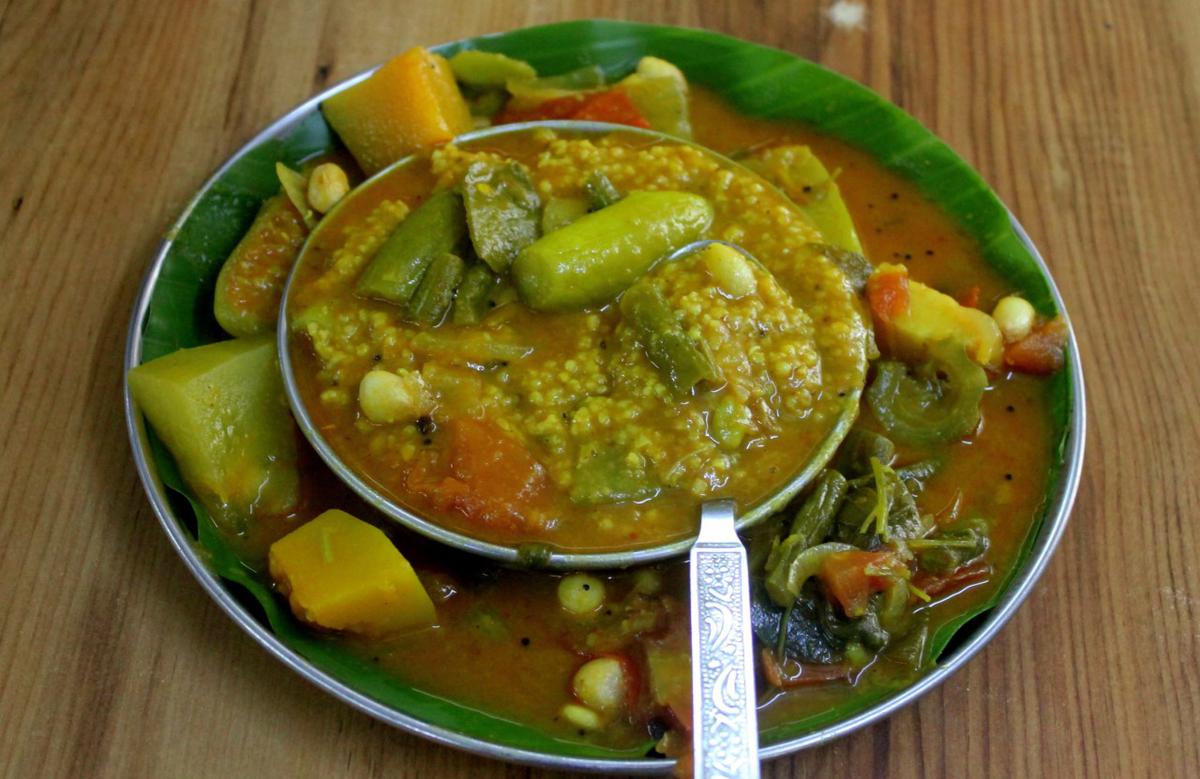
Kadhamba Sambar
| Photo Credit:
Special Arrangement
Ingredients
Lemon size tamarind – lemon size ball
Turmeric powder 1 teaspoon
Asafoetida 1/2 teaspoon
Sambar powder 1 1/2 tablespoon
Tomatoes 2 medium size
Lima beans or broad beans seeds ( mochai/ avarai ) 3/4th cup
Fresh peanuts 1/2 cup
Chopped yardlong beans (Karamani kai) 1/2 cup
Chopped broad beans 1/2 cup
Elephant yam 1/2 cup
Ash gourd/ white pumpkin (with skin) 1/2 cup
Yellow pumpkin (with skin) 1/2 cup
Sweet potato 1/2 cup
Toor dal 1 1/4 cups
Salt as required
Ghee or sesame oil, as required for tempering
Mustard 1/2 teaspoon
Cumin 1/2 teaspoon
Curry leaves two sprigs
Minced coriander leaves – 4 teaspoons
Preparation
- Soak the tamarind in three fourth cup hot water. Set it aside for 20 mins and then extract the pulp.
- Chop all the vegetables and keep aside. Pressure cook 250 grams, mash well and keep aside.
- To thick bottom vessel, add the chopped tomatoes, and cook on medium flame, for about three minutes.
- Once the tomatoes are soft add turmeric power, asafoetida powder and mix it in.
- To this, add the tamarind extract, and bring it to boil. Let it boil for three minutes and bring it down to a simmer.
- Then add the vegetables one-by-one with a minute gap between each addition. Start with the beans, then peanut, yam, sweet potato and so on
- Add water, just enough for vegetables to immerse completely. Let the vegetables boil for five minutes, then add the sambar powder mix well and add salt as required.
- Let this cook for three to five minutes, and then add the cooked and mashed toor dal. Don’t let the sambar be thick, adjust the consistency by adding water as needed.
- Now, taste and check for salt or if more sambar powder is required. You can also add more tamarind extract if required. After checking for flavour and adjusting, cook on low flame for 10 minutes, but keep stirring every two minutes so that it does not get burnt. Switch off.
- For tempering, heat ghee or sesame oil in a pan. Once it heats up add mustard and cumin. When it splutters, add the curry leaves and asafoetida, and pour it over the sambar. Sprinkle the coriander leaves and immediately close with a lid. Let it rest for an hour and then it will be ready for serving.
- Serve over millet of your choice with a side of crisps.
Recipe by N.S. Krishnamoorthi
Foxtail millet (Thinai) sweet pongal
Serving size: 2-3
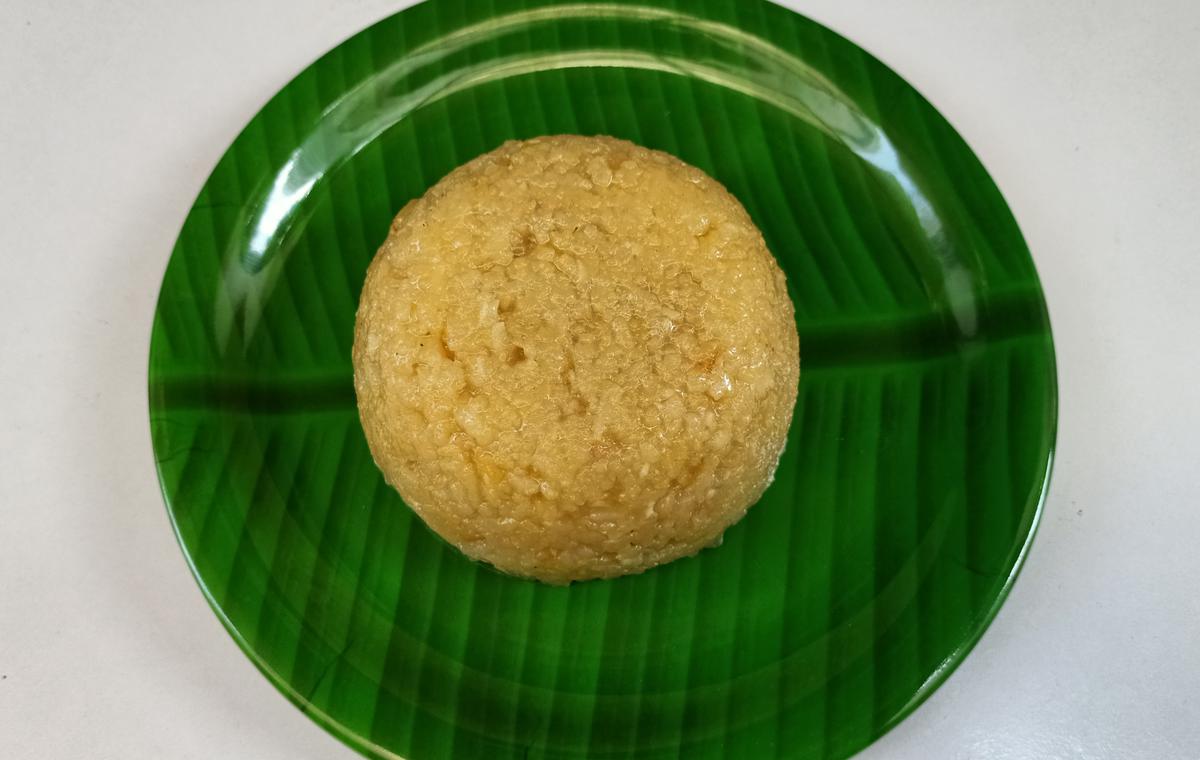
Sweet Pongal
| Photo Credit:
Wikimedia Commons
Ingredients
Foxtail millet (Thinai) 1 cup
Dry Mung beans (Moong dal) 1/2 cup
Powdered Jaggery 1 3/4 cups
Chopped cashews 1 tablespoon
Raisins 1 tablespoon
Cardamom 2 pods
Ghee or coconut oil for tempering
Preparation
- Dry roast the millet in low flame for a few minutes and set it aside
- Dry roast the moong dal till u get a good aroma and set it aside
- Roast the cashews and raisins in ghee or coconut oil and set it aside
- In an open pot, add one litre of water and bring it to a boil
- Once it boils simmer the flame and add the roasted millets and moong dal
- Once the millet and moong dal turn soft, add the powdered jaggery and keep stirring.
- Once the powdered jaggery has been completely incorporated, allow the mixture to thicken
- Add cardamom, roasted cashews and raisins to the pongal
- Serve hot
Recipe by Seethalakshmi M. Organic Farmers Market, Chennai
Kanu Pongal / Kaanum Pongal
Millet Lemon Rice
Serving size: 3
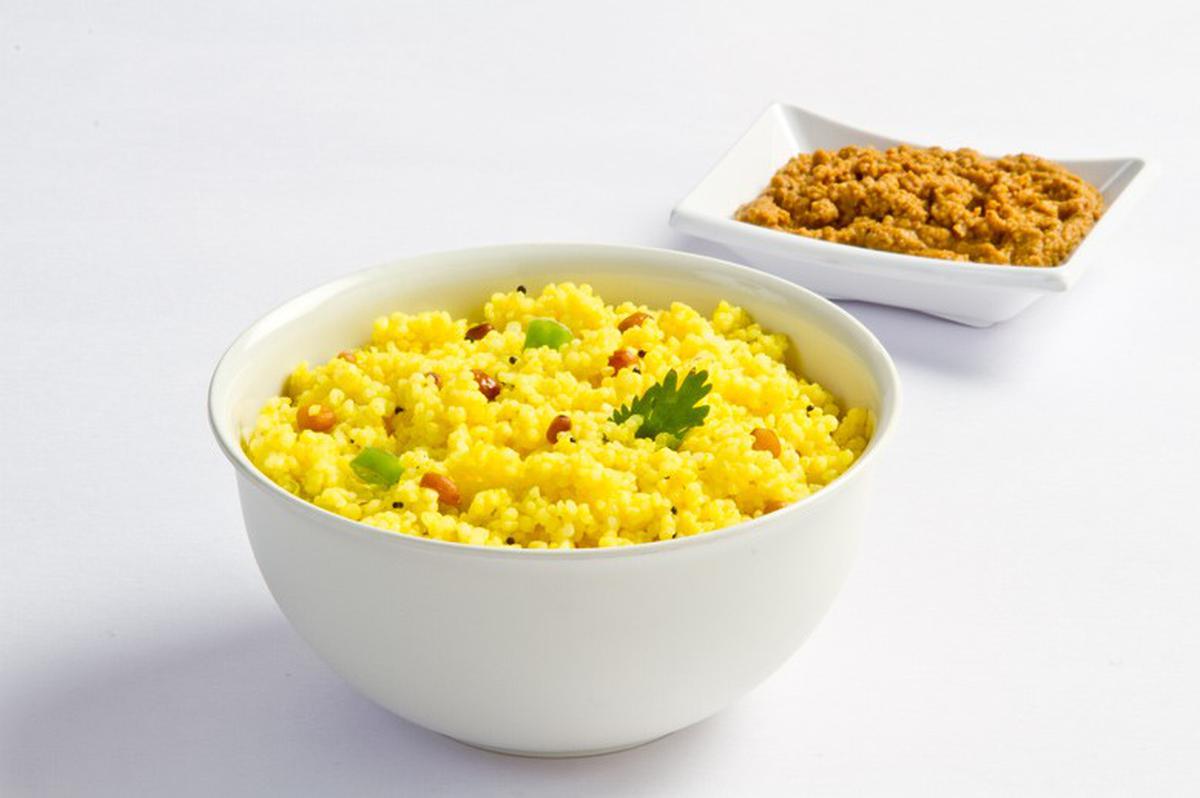
Millet Lemon Rice
| Photo Credit:
Special arrangement
Ingredients
Kodo Millet (Varagu) 1 cup
Lemon (medium size) 2
Sesame oil 4 tablespoons
Mustard seeds 1 tablespoon
Channa dal 1/2 tablespoon
Urad Dal 1/2 tablespoon
Chopped Green Chilli 1 1/2 teaspoon
Finely chopped Ginger 1 1/4 teaspoon
Raw peanuts 3 tablespoons
Curry leaves 2 sprigs
Turmeric powder 1 teaspoon
Chopped coriander 1 1/2 tablspoons
Salt to taste
Preparation of lemon-mix
- Squeeze the juice of two lemons and add salt to it.
- Add sesame oil to a pan and once the oil heats up add the mustard seeds.
- When the mustard seeds sputter, add bengal gram and urad dal. Saute it until it turns golden brown.
- Add the chopped green chilli, peanuts, curry leaves, turmeric powder to the above mixture and saute it well. Add this mixture to the prepared lemon juice.
Preparation of Kodo Millet (Varagu Rice)
- Wash the raw kodo millet with clean water three to four times.
- Soak in water for 15 minutes.
- To an open pot add one and a half to two litres of water and bring it to a boil.
- Bring the water to a boil and then few crystals of rock salt, followed by the washed millet.
- Once it begins to boil, reduce the flame to simmer.
- Cook it for three to five minutes or till the millet absorbs the water and turns slightly transparent.
- To avoid overcooking, switch off the flame and add two cups of cold water to the cooked millet.
- Strain the millet and allow the water to drain completely. Spread it on a large plate and allow it to cool.
- Sprinkle sesame oil over the millet to prevent the grains from sticking with one another and spread it evenly.
- Add the lemon-turmeric mixture to the cooked varagu and add salt or lemon to taste.
- Serve with pickle or chutney.
Recipe by Adhi Eswari, Founder of Millet Maagic Meal restaurant, Chennai
Curry Leaves Kodo Millet (Kariveppilai Varagu Sadam)
Serving size: 3
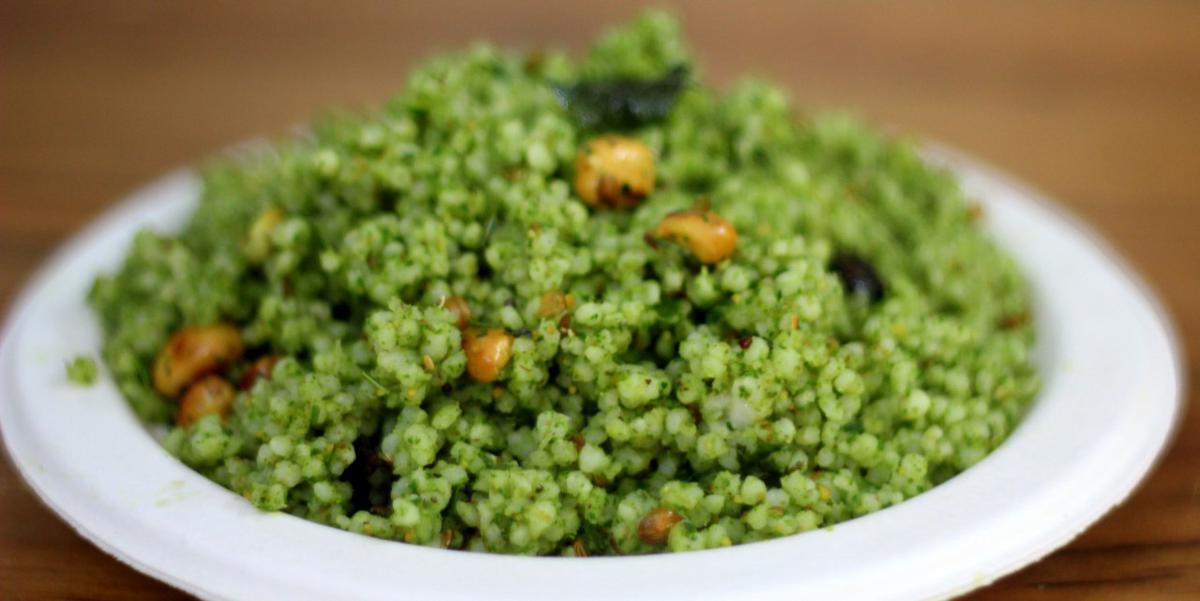
Curry Leaves Kodo Millet
| Photo Credit:
Special Arrangement
Ingredients
Kodo millet 1 cup
Curry leaves 3 cups
Urad dal 1 teaspoon
Channa dal 1 teaspoon
Dry red chillies 4 to 6
Peanuts or cashews 1 tablespoons
Tamarind – one gooseberry sized ball
Cumin (Jeera) 1 teaspoon
Salt to taste
Ghee or sesame oil 1 tablespoon
Preparation
- Roast the millets in two teaspoon of ghee and soak it water for 30 minutes
- Add the soaked millets to an open pot with two cups of water or in a pressure cooker for two whistles.
- Now, spread this rice on a flat wide plate and allow it to cool. Ensure it is not soggy or sticky but must be grainy.
- To a wide pan, add ghee or sesame oil add the urad dal, channa dal and dry red chillies and fry them in medium flame.
- After two minutes, add the tamarind and curry leaves. Stir it gently and and swtich off the stove. Let it cool completely and then grind it to a powder.
- Add two to three tablespoons of water and grind it further to a chutney-like consistency.
- To the same kadai, add two teaspoons of sesame oil add ground nut or cashew fry till light golden.
- Then add cumin, and when it splutters, add the ground chutney and cook for a minute. Add salt and lower the flame and then add the cooked millet. Gently mix till the rice is completely mixed with chutney.
- Check for salt. You can add chilli flakes (optional)for extra spice and taste.
Recipe by N.S. Krishnamoorthi
Stay connected with us on social media platform for instant update click here to join our Twitter, & Facebook
We are now on Telegram. Click here to join our channel (@TechiUpdate) and stay updated with the latest Technology headlines.
For all the latest Food and Drinks News Click Here
